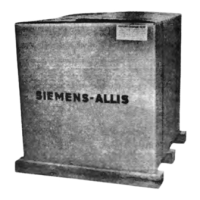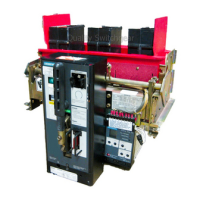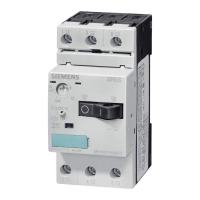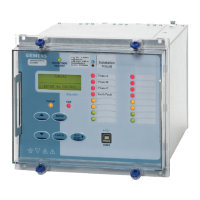,
'
..
..
e
MAINTENANCE
•
•
type spring scale can be used
to
compress
contact
fingers
(46) with breaker open.
Contact
pressure should be
between
20
and
30
pounds (9.1-13.6 kg) on each finger.
ARCING
CONTACT
MAKE
SEE FIGURE
6.
With the movable arcing
contact
(62) in
any
one phase
touching
the mating stationary
contact
when the
circuit
breaker is closed
by
the maintenance closing method (see
Table 5), the phase-to-phase variation should
not
exceed
.062" (1.6 mm).
Adjustment
may be made by
positioning
screws (78) as in the previous paragraph.
It
is
essential
that the main
contact
compression be maintained
within
the tolerance listed in the previous paragraph. Arcing
con-
tact pressure should be between 30 and 40 pounds (13.6-
18.2 kg) when checked with a
pull-type
spring scale
at
the
base
of
the arcing
contact
tip
insert with the
circuit
breaker contacts closed. Measure each blade separately.
CONTACT
REPLACEMENT
SEE FIGURE
6.
The
contact
structure consists
of
main
current
carrying
contacts and arcing contacts arranged so that initial
con-
tact make and final
contact
break is
by
means
of
the
arcing
contacts. The actual
contact
surfaces are clad
with
an
alloy facing which greatly reduces mechanical wear and
arc erosion.
When inspection
of
the alloy
facing
indicates
that
the
contacts should be replaced,
it
should
be
noted
that
hinge
contact
fingers (53,55) main
contact
lingers
(46) and
arc-
ing
contacts
(61) are spring loaded. Therefore-, care must
be used in removal and installation
of
any
of
the contacts.
MAIN CONTACT FINGERS
SEE FIGURE
6.
With the
circuit
breaker
contacts
open and the stored
energy springs discharged, the
main
contact
fingers (46)
may be removed
by
loosening screws (44,45)
enough
to
relieve the compression on springs (47,48). There are
two
springs
behind each finger.
It
is
important
that
they
be
positioned
properly
upon reinstallation.
If
difficulty
is
experienced in
correctly
positioning
these springs,
the
upper
and
lower
primary disconnects (Parts Section Fig-
Page 13
ure2,
Item 168), may be removed
from
each phase and
the
circuit
breaker inverted
to
rest on the ends
of
connectors
(37) and (49).
After
the
contact
fingers
are replaced,
con-
nector
(37) should be positioned in the
center
of
the
slot
in
the molded base
to
assure
correct
alignment
of
the
pri-
mary disconnect fingers.
STATIONARY ARCING
CONTACT
SEE FIGURE
6.
The stationary
arcing
contact
(146) is a
part
of
connector
(37) and may be replaced
by
proceeding
as above. In this
case, screws (44,45) must be removed. However,
to
pro-
vide clearance
for
removal
of
connector
the backpanel
(33) may have
to
be loosened
by
removing screws 58, 59
and
23
(Figure
2,
Page 26).
By
removing pins (98 & 99
Figure
2,
Page 26) the entire assembly can be lifted out.
HINGE
CONTACT
FINGERS
SEE FIGURE
6.
Hinge
contact
fingers
(53,55) may
be
removed as follows:
Remove backpanel. Remove
lower
connector
(49) and
moving contacts by removing screws (59). The
springs
(54,56) are unloaded
by
rotating the
moving
contacts
toward
a horizontal position relative
to
the stationary
con-
tact (49). Remove screws (70)
to
remove
moving
contacts.
Slide fingers (53,55) sideways
to
remove. Replace
fingers
by
compressing
spring
(56,54)
in
position and
inserting
the
lingers
from
the side.
Holding
connector
(49) in a vise
aids the operation.
MOVABLE ARCING
AND MAIN
CONTACT
SEE FIGURE
6.
Either movable
arcing
contact
(61),
or
main
contact
(62),
or
both, may
be
removed and replaced as follows: .
Remove
moving
contacts
as above. The
complete
mov-
able
contact
assembly may
now
be
brought
to
the bench.
The
location
of
spacers should
be
noted. Loosen
nuts
(80)
and remove screws (78) from
pin
(71),
alternate
several
turns each side
to
prevent
binding.
Courtesy of NationalSwitchgear.com

